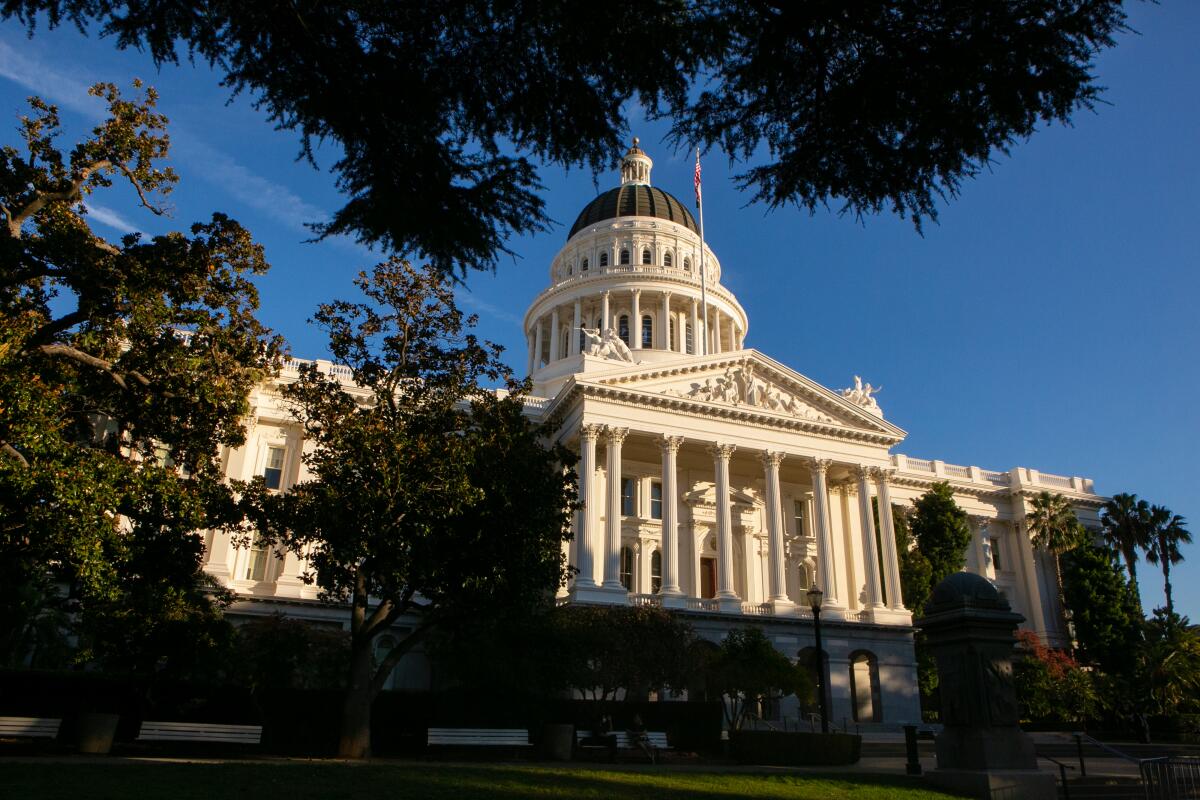A huge California budget surplus will test legal spending limit, analysts warn

- Share via
SACRAMENTO — California lawmakers should take early action next year on how to implement the state’s constitutional spending limit, an analysts’ report recommended Wednesday, pointing out that the longstanding law will dictate how to divvy up almost all of a towering $31-billion tax surplus.
The spending limit, approved by voters in 1979, was a key consideration during state budget negotiations last spring after largely lying dormant for the past four decades. Successive years of higher-than-expected tax revenues, even during the economic disruption of the COVID-19 pandemic, have allowed Gov. Gavin Newsom and Democratic legislative leaders to expand government services while also paying down long-term debts and boosting the state’s cash reserves.
When state officials craft a new budget next spring, the independent Legislative Analyst’s Office projects, they could find that the spending limit controls the use of all but a few billion dollars of the surplus in a period spanning between now and the early summer of 2023.
“We think it will turn out to be a pretty significant issue for the Legislature to consider in this coming budget process,” said Legislative Analyst Gabriel Petek.
In their annual report released Wednesday, Petek and his analysts found the surplus tax revenues would be counted toward multiple fiscal years. But most of the windfall — more than $22 billion — is paid in taxes collected during the current budget year, which began July 1 and runs through June 30 of next year. Substantial portions of the overall budget bonanza will go toward funding K-12 schools and community colleges. The analysts project guaranteed school funding will have increased by some $11 billion over the period between mid-2020 and next summer, with higher spending required after that.
Petek said that California’s strong tax revenue collections appear to be broad-based and that its economy has likely been strengthened by the sweeping pandemic assistance efforts of the federal and state governments. Even so, the state budget relies strongly on high-income earners and the successes or setbacks they experience with their investments in the stock market. The report finds that tax collections from all sectors combined grew at an annual rate of 30% over a 12-month period ending in September — the fastest rate since at least the early 1980s.
The sustained growth in tax revenues gave lawmakers an opportunity this year to make large investments in a variety of education, healthcare and social services programs. One-time decisions to provide stimulus checks, as well as renter and business relief, were also made possible by surplus dollars not otherwise committed to mandatory spending or cash reserve requirements. The state has also made public employee pension payments above minimum levels and committed billions toward new efforts to combat homelessness across California.
But when lawmakers return to Sacramento in January to consider the budget plan Newsom will propose for the coming year, they will be faced with what the analysts say are new challenges in how to interpret the 1979 spending limit. That law, enacted by voters following implementation of the landmark property tax limitations of Proposition 13, requires some excess tax revenues to either be dedicated to special state expenses or divided between providing additional money for schools and rebates to taxpayers.
Newsom did not directly answer a question about whether he would recommend adopting the spending limit’s provisions related to education and tax rebates when asked about the analysts’ report at a news conference Wednesday in Los Angeles related to the state’s role in easing global supply chain problems.
“I look forward to making the decision that I think is in the best interest of 40 million Californians in January with support, critical support of our legislative leaders,” he said.
Times staff writer Taryn Luna contributed to this report.
More to Read
Sign up for Essential California
The most important California stories and recommendations in your inbox every morning.
You may occasionally receive promotional content from the Los Angeles Times.














